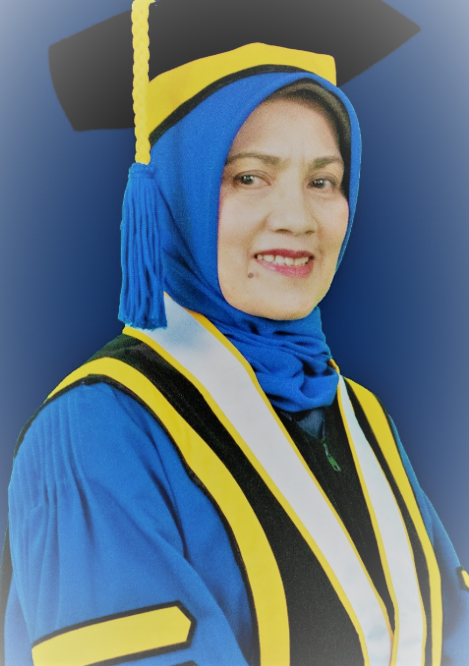
fsm.undip.ac.id Endah Dwi Hastuti was inaugurated as Professor of Plant Ecophysiology at the Department of Biology, FSM UNDIP. This woman who has been blessed with 5 grandchildren has developed the Mangrove Model Rehabilitation method (Dual Buffered Silvofishery). In its development, the DBS model is also known to have a better mangrove survival rate than other models.
Prof. Endah, as her colleagues and students greeted her, delivered a scientific speech entitled “Development of a Mangrove Integration Model in Plant Ecophysiology-Based Ponds for Sustainable Management” at the inauguration of the highest academic achievement. According to the graduate of the Doctoral Program in Environmental Sciences from the Undip Graduate School, DBS is a mangrove integration model designed to overcome the weaknesses and problems of the mangrove integration model in existing ponds. “In the DBS System, planting is done at the input and output of the pond,” said the person whose full name is now officially written as Prof. Dr. Dra. Endah Dwi Hastuti, M.Si.
Referring to the data Food and Agricultural Organization (FAO), this expert born in Boyolali 5 May 1961 said that the wealth of mangroves in Indonesia, which reached 43 species, was the highest in the world. It’s just that 34 of the 43 types of mangroves are known to have a declining population status. In fact, according to data from The International Union for Conservation of Nature (IUCN), 1 species is listed as critical, 2 species are threatened with extinction, 1 species is vulnerable, and 3 species are near threatened with extinction.
One of the contributing factors is quite large on the shrinkage of mangrove area is the conversion of mangrove land into ponds. As much as 60% of the depreciation occurred due to the conversion of mangrove land into ponds, especially in Java, Sumatra and Sulawesi. Therefore, it is necessary to encourage the rehabilitation of mangroves in ponds, not only as an effort to preserve the environment, but also to improve the pond ecosystem to make it more efficient.
Endah, who teaches 12 courses every day on campus, is intensely studying and developing biological sciences. All of the courses he teaches include Plant Physiology, Plant Anatomy, Cell Biology, Seed Technology, Plant Ecophysiology, Nutrient Physiology, Post Harvest Physiology, and Bioremediation and Biofuels based on biology.
The DBS model, according to the grandmother of 5 grandchildren, is a model created as an effort to rehabilitate mangroves in aquaculture areas through silvofishery. This effort aims to restore mangrove cover while still providing space for cultivation activities. fish. This model needs to be developed because the integration of mangrove ecosystems in ponds that are widely applied is not optimal because it does not consider the ecophysiological aspects of plants so that the survival rate is inadequate.
Ecophysiology itself is the study of the mechanism of living things in responding to the microenvironment. By considering the ecophysiological aspects for planting plants in artificial ecosystems, it can be seen the suitability of the environment so that the effectiveness and efficiency of planting can be obtained as expected.
He revealed that the Dual Buffered Silvofishery (DBS) model as a mangrove integration model can overcome the weaknesses and problems of other mangrove integration models. Through testing the DBS model carried out in Mangunharjo, Tugu District, Semarang City showed a higher level of effectiveness in wanamina ponds (a mixture of mangrove and ponds). This is indicated by the survival rate, metabolite content, and growth rate.
“Management of mangrove ecosystems that are integrated with ponds is very good and necessary because it can maintain the optimal functionality of mangroves in ponds. The integration of mangroves in ecophysiology-based ponds that are well managed can have positive ecological, economic and social impacts. Ecologically, the integration of mangroves in ponds can maintain environmental quality through the environmental services provided,” the mother of three children who completed her undergraduate and postgraduate studies at Gajah Mada University (UGM).
Economically, the optimal DBS integration model can reduce management costs and increase pond productivity. The existence of mangroves in ponds will encourage the emergence of natural food, so that it can save the need for artificial feed needed in the cultivation process. Pruning over fertile mangroves also makes useful compost. Meanwhile, the resulting social impacts are obtained from the aesthetics of the environment and the availability of the field job.
As the Head of the Department of Biology, FSM Undip, he said he was grateful to have two additional professors, including himself, so that now he has 4 professors. The wife of Ir Sunarto MP is also grateful for the willingness of her husband, children and grandchildren to give space and time to complete the administrative requirements to achieve the highest academic positions. “It’s not easy to do, because it can’t be left to someone else. But Alhamdullilah everything can be resolved. I feel like a real professor because I got it when I had five grandchildren,” he said half jokingly. (SPA)

